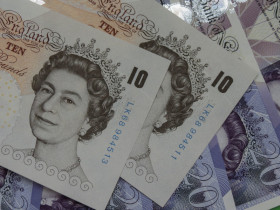
The British pound is rising against many of its currency rivals on Thursday after the central bank left interest rates and its aggressive asset-buying program unchanged. But while the decision to hold things steady was widely expected, many analysts are combing through the Bank of England (BoE) headâs remarks that subzero interest rates are in the institutionâs âtoolbox.â
During the August policy meeting on Thursday, the BoE voted unanimously to leave its benchmark interest rate at 0.1%, the lowest it has been in history. The central bank also decided to maintain its aggressive $982 billion quantitative easing program. It did not provide a signal as to when it would relax its stimulus and relief efforts, adding that the economy would not return to pre-pandemic levels before the end of next year.
However, the BoE is a bit more optimistic about the national economy in the short-term. The central bank, for example, sees the unemployment rate at 7.5% by the end of 2020. This is below the initial estimate of about 10% three months ago. That does not mean the BoE will hold off on additional stimulus for the British economy, with January becoming a key month for policymakers to decide on pulling the trigger on another round of money-printing or leaving things the same.
But what about inflation? Today, inflation stands at an annualized rate of 0.6%, but it could slump to 0.25% later this year. The BoE is sounding the alarm that it could take two years for inflation to reach its 2% target. What makes the inflation subject compelling is the option of introducing negative rates.
The BoE offered the clearest indication that it no longer believes subzero rates are forbidden.
Governor Andrew Bailey told CNBC that there are no plans to bring interest rates to below zero, but he confirmed that it is something inside its âtoolbox.â
What I can tell you is that other analysts are essentially right, in the sense of saying it is in the toolbox. But, there is no plan at the moment to bring it out of the toolbox and put it to work.
Weâve looked at the experience of other central banks. I think there is a close relationship between the effectiveness of negative interest rates and the structure of the banking system, particularly the amount of retail funding. And also, the point in the economic cycle at which they have been used in different countries.
Looking at that and looking at our situation, it makes sense to say: Look, we need as many tools in the box as we can get at the moment because obviously, we are in a constrained position with interest rates as low as they are.
In the end, however, Bailey confirmed that officials are not discussing it at the present time.
On the data front, the IHS Markit construction purchasing managersâ index (PMI) surged to 58.1 in July, up from 55.3 in June. This came in better than the median estimate of 57.
The GBP/USD currency pair rose 0.4% to 1.3165, from an opening of 1.3114, at 14:04 GMT on Thursday. The GBP/JPY advanced 0.18% to 138.72, from an opening of 138.46.
If you have any questions, comments, or opinions regarding the Great Britain Pound, feel free to post them using the commentary form below.